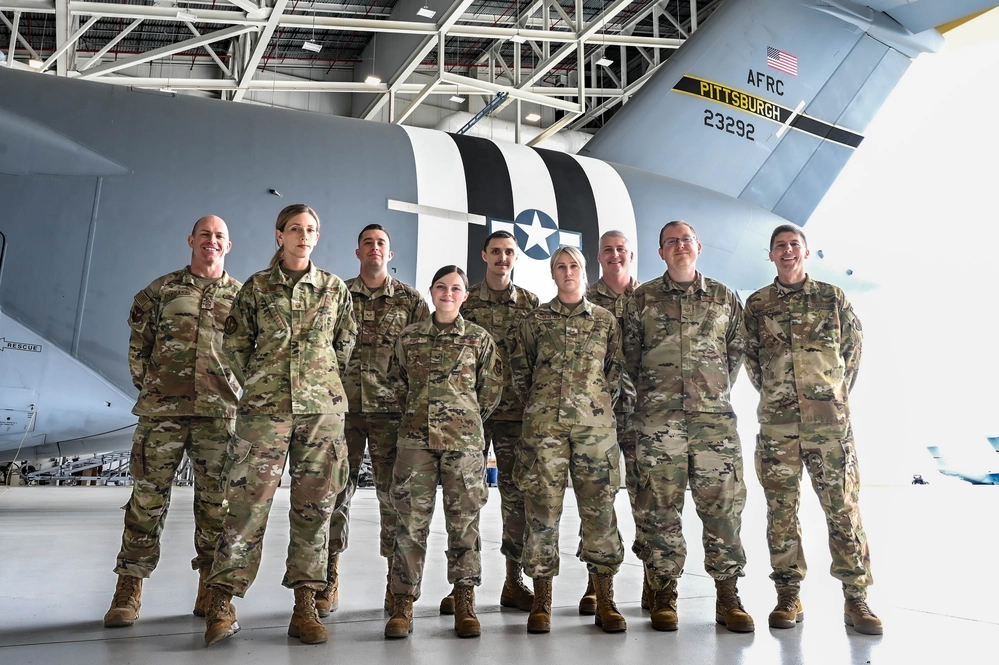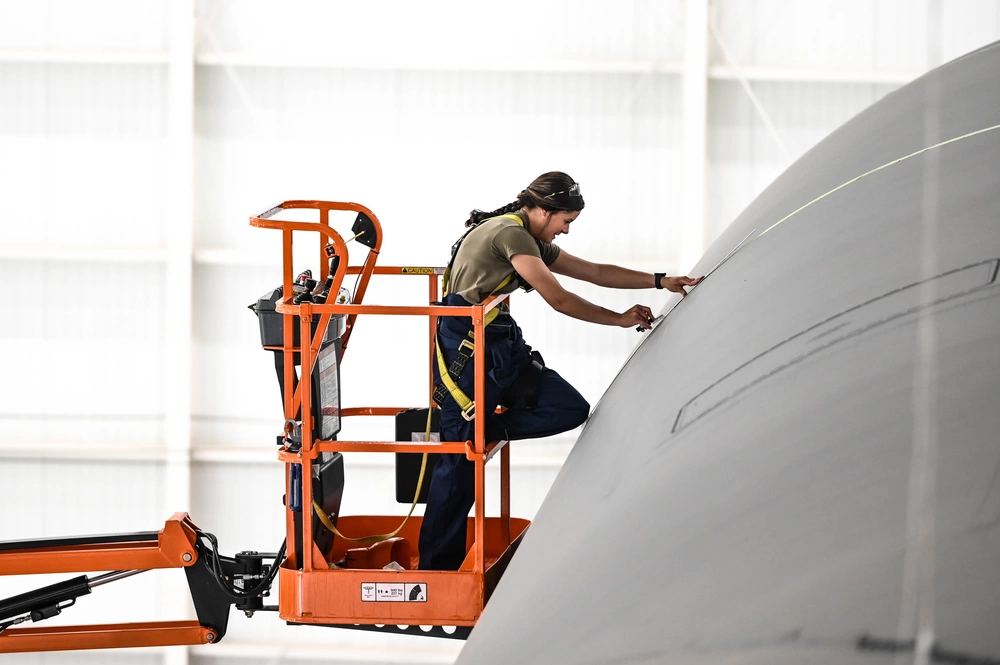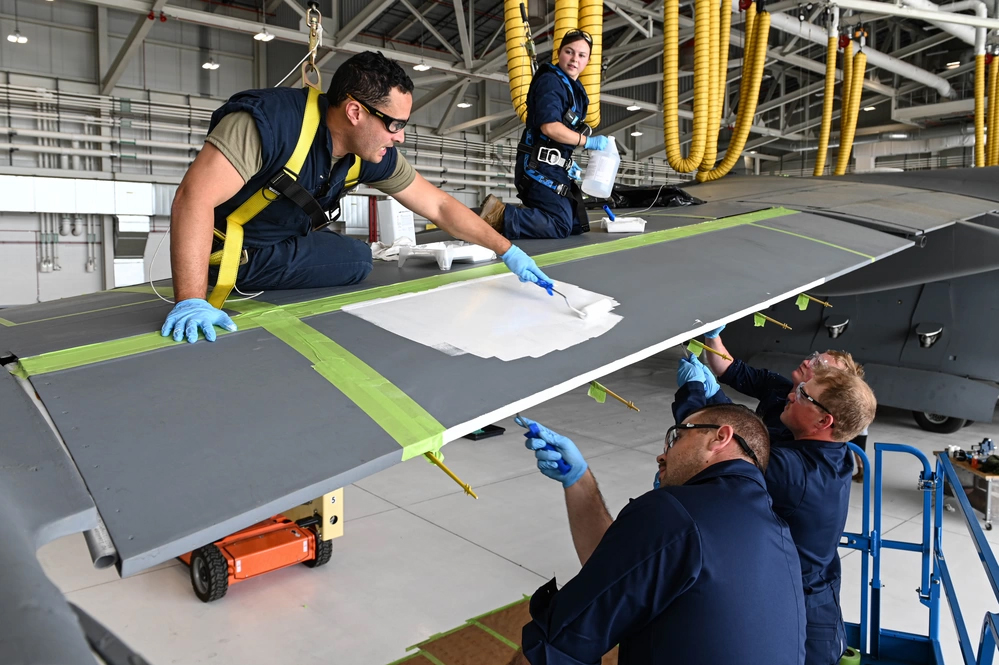911th Airlift Wing Honors Veterans with WWII Paint Job
By Jeffrey Grossi
Published July 3, 2023
Read Time: 5 mins
Editor’s note: This is an abridged version of a story initially published on June 22, 2023, by the Air Force Reserve’s 911th Airlift Wing Public Affairs Office. The full story can be found here.
In a nod to aviation history, 20 Airmen assigned to 911th Maintenance Squadron painted World War II invasions stripes on a C-17 Globemaster III aircraft assigned to the 911th Airlift Wing at Pittsburgh International Airport Air Reserve Station from June 5-14, 2023. The project was inspired by the 79th anniversary of the D-Day landings, the day the Allies invaded Western Europe in World War II.
The black and white stripes, originally used to distinguish Allied aircraft from enemy planes at Normandy, serve as a visual tribute to the heroic efforts of the past while representing the continued dedication of the 911th Airlift Wing to “Defend, Mobilize and Fight.”
The decision to add the invasion stripes was made by the leadership of the 911th, who see it as an opportunity to honor the sacrifices and bravery of those who fought in World War II.
Col. Bryan Bailey, commander of the 911th said, “Heritage is important. We stand on the shoulders of Airpower giants who came before us, and it is OK to remind the world – and ourselves– just how awesome the U.S. Air Force is.”
Bailey went on to say the daily skill of Airmen may lead some to take for granted the overall difficulty of achieving air dominance, but invasion stripes may serve as a reminder.
“We’re the ones who figured out how to fly bombers off carriers, how to tow gliders full of soldiers to the beaches of Normandy. We are the reason no soldier, sailor, airmen, Marine or guardian has come under direct attack from the air for three-quarters of a century,” said Bailey. “I’m proud of that. Having this aircraft around – even temporarily – reminds everyone of not only our heritage but also our capability.”

Seven of 20 aircraft structural technicians assigned to the 911th Maintenance Squadron responsible for painting the first-ever invasion stripes on a C-17 Globemaster III pose for a photo with Col. Christopher J. Sopko, 911th Airlift Wing vice commander, and Chief Master Sgt. Dennis G. Jendrzejewski, 911th Airlift Wing command chief, June 14, 2023, at Pittsburgh International Airport Air Reserve Station. (U.S. Air Force photo by Master Sgt. Jeffrey Grossi)
The aircraft will keep its stripes for a 365-day period with their removal landing on the 80th anniversary of D-Day as per the Heritage Aircraft Programs regulations.
While the decision to display the regalia of the past was a command level decision, the design and its execution fell onto the Steel Airmen of the aircraft structural maintenance shop, a process which began long before a hand even touched a paint brush.
“It’s been months,” said Senior Master Sgt. John Revell, fabrication flight chief assigned to the 911th MXS. “I’d say February is when we started getting an idea together. Looking at the plane, how to do it, where and what we needed. But once that approval came through, the team was right on it. It actually worked out well because we had people scheduled for annual tour… the stars just aligned.”
A handful of those Airmen were Tech. Sgt Joseph Cider, Tech. Sgt. Jim Krobot, Staff Sgt. Natalie Rupp, and Staff Sgt. Leah Weingartner, all aircraft structural technicians assigned to the 911th MXS.
“Well, I think we didn’t really know what to expect going into it,” said Rupp. “I think we all had to use each other’s ideas to form a plan of what we were going to do. Who’s going to work under the wing? Above the wing? How are we going to lay this out? How are we going to get straight lines?”
The biggest challenge with being the first people to do something new, it seems, is having no instructions, technical orders, or experiences to fall back on.
“Yeah, there was no recipe for anything, and I think that was the hardest part.” said Weingartner. “But once that was done it was like, ‘Okay, we just roll it on now.’”
And that seemed to be the key – professionalism coupled with communication and teamwork. These qualities were seemingly primed in this group of 20 maintainers who work together for just one weekend a month.

Tech. Sgt. Michelle Rozich, aircraft structural technician, tapes off the fuselage of a C-17 Globemaster III before painting invasion stripes, June 6, 2023, at Pittsburgh International Airport Air Reserve Station. When it finally came time to paint, Steel Airmen broke into teams and used screen ink thinned with acetone to slather on the stripes. (U.S. Air Force photo by Master Sgt. Jeffrey Grossi)
Airmen would meet multiple times during the day to communicate issues coming up and try to figure out the best way to stay ahead of them, seeking a proactive approach to looming trouble. With a project of this scope, even a half-of-an-inch mismeasured at the start can become a considerable deviation 13 feet down the line.
“Surface prep is the most important step,” said Rupp. “That’s what they told us in tech school.”
When it finally came time to paint, Steel Airmen broke into teams and used screen ink thinned with acetone to slather on the stripes. Teams stuck to their areas of responsibility such as above the wing, under the wing and sections of the fuselage. Others ran ink and tools, such as rollers, as supplies ran low or disintegrated.
The painting process took 88 hours of labor and 15 total gallons of white, black and blue ink, 12 gallons of acetone, and 22 rolls of tape to complete.
Although being first may have been all the motivation the crew needed to get the job done, Weingartner said it was more than that. It circles back to those who came before.
“It is cool that we were the first C-17 to do this,” Weingartner said. “Every brush stroke felt significant knowing we were adding to a piece of history. But we wanted to do it and to get it right to honor that day and the legacy of those who fought for freedom and democracy.”
Watch
This Next
Read
This Next






